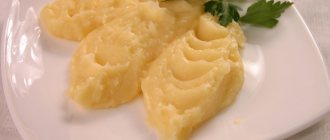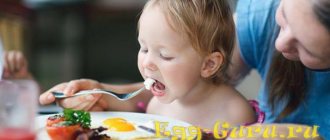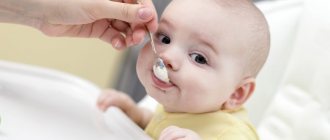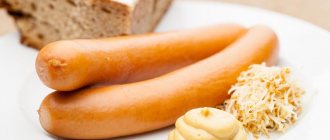The effect of peas on the children's body
The list of beneficial properties of peas does not end there; it has the following effects on a child’s growing body:
- improves the functional development of the baby’s brain;
- perfectly replenishes strength and energy, which is especially important for active kids;
- relieves the child from excessive nervousness and capriciousness;
- is a source of valuable vegetable protein that can replace meat products;
- has a beneficial effect on the process of hematopoiesis, prevents the development of anemia;
- improves elasticity and permeability of capillaries;
- It is one of the dietary and hypoallergenic products, which makes it possible to introduce peas into the diet of children who are susceptible to allergic reactions.
However, many mothers believe that legumes will cause the baby’s tummy to swell and cause colic and diarrhea. Is it possible to protect a baby from such unpleasant consequences? In fact, it is quite possible to avoid flatulence; to do this, you need to take into account several important nuances:
- for feeding a baby, it is better to use legumes of milky ripeness, ideally if they come from your own garden;
- Whole peas cannot be given to children under 2 years of age; they must be pureed;
- Pea-based dishes should be introduced into the diet of babies gradually.
Pea porridge
You can give porridge to children. We also soak the peas before cooking. After this, boil, you can pass the finished porridge through a blender. Add ½ teaspoon of vegetable oil.
Personal experience! Natalya, 23 years old: “I started introducing peas to my son when he was 2 years old. He liked him immediately. We tried it in the form of soups, porridges, purees. I also added it to salads in the form of green peas. I didn’t notice any allergic reactions.”
Pea porridge can also be mixed with vegetables or minced meat, which will only improve its taste.
Complementary food in the form of pea soup
There is no consensus on the age at which pea soup, porridge or puree can be included in a child’s diet. Pediatricians categorically prohibit feeding babies under one year old with such food. However, some mothers offer peas to their babies at an earlier age, for example, at 9-10 months. This is acceptable if the baby has already mastered other types of complementary foods and tolerates food well.
When introducing legume complementary foods, several rules should be followed:
- Start giving your baby pea soup preferably in the first half of the day;
- initial portions should not exceed 2 tablespoons in volume;
- You should not start your meal right away with peas; it will be difficult for the child’s digestive tract to process such food;
- you need to gradually increase the amount of food, eventually bringing its volume to a full portion;
- It is imperative to carefully monitor the body’s reaction; if you notice that the baby’s gas formation has increased, you should slightly reduce the daily portion of soup;
- peas for the first feeding should be chopped with a fork or blender, that is, you get a puree soup;
- the frequency of consumption of legume soup should not exceed once every 2-3 days;
- On the same day as peas, you should not give your baby nuts, sausages, fish or natural juices.
When should you start feeding your baby pea soup?
A balanced and varied diet for your baby is the key to his future good health. All parents know this simple truth. However, many of them have difficulties: at what age can a child have pea soup or is it better to avoid it altogether?
Basic recommendations
It is necessary to take into account: soup for a one-year-old child has a significant difference in characteristics from what his parents are used to cooking in a common pan for lunch.
Basic recommendations from pediatricians and nutritionists:
The first dish brings undoubted benefits to the child only if it is prepared by the mother according to all the above rules, with love. Such soups contain the nutritional components and microelements necessary for the baby, helping him grow healthy and happy.
What are the benefits of soups
Children enjoy trying and learning about vegetable, cereal and even fruit soups. Using a variety of ingredients develops the baby’s taste abilities and helps him explore the world.
First courses serve as the main source of energy for the baby’s growing body and nutrients for the full growth of organs. According to the benefits they bring, soups are divided and evaluated as follows:
- Vegetables are a greater source of mineral salts, as well as organic acids and dietary fiber.
- Cereals – supply natural protein to the child’s body, as well as some mineral salts and subgroups of vitamins.
The main composition of a pea dish
Experts emphasize that legumes are preferable in the diet due to their composition, the presence in them of a large amount of fiber, microelements, as well as oils and healthy carbohydrates. However, the situation with pea soup is a little different.
For a growing baby's body, it is better to choose young green peas. If it is not available, it is permissible to use ground peas soaked overnight. And for classic soup recipes, really dry peas are taken, which do not become soft during the cooking process.
Potatoes and carrots may also be present in the soup if the baby has already tried them and has not developed any allergic conditions.
At what age is pea soup allowed?
Young parents ask the pediatrician many questions, including about the proper nutrition of their baby: when can they give their child pea soup. If we rely on the recommendations of world pediatricians, then no earlier than 2.5-3 years.
Puree soup, which is more reminiscent of pea porridge, is offered with great caution to children from two years of age. The classic dish, beloved by Russians, is introduced into the diet of children no earlier than 4.5-5 years old, and with seasonings and herbs #8212; from 6–7 years old.
Among the limitations, specialists indicate the pathologies of the baby’s stomach and pancreas. Therefore, if you want to diversify your child’s diet, you should not rush: each dish has its own time limit.
How to cook and how to give correctly
When introducing a child to pea soup, pediatricians recommend limiting it to a minimum of ingredients. The easiest way: boil peeled crushed peas in recycled chicken broth, then carefully grind them to a puree, for example, in a blender.
Various fried vegetables, herbs, and seasonings are prohibited. It is also undesirable to start a meal with pea soup: it is difficult for the baby to digest and prevents the complete digestion of other dishes.
For the first feeding, 2-3 spoons of puree are enough, and with each subsequent feeding the volume of the dish increases by 1⁄2–1 spoon. On average, the volume should not exceed 100–120 g for a child under 3 years old.
On the same day as pea soup for lunch, it is not advisable to give anything else, for example, fish, nuts, sausages or natural juices. This may trigger an allergic condition or diarrhea.
How to properly prepare pea soup for a baby?
There are many ways to prepare pea soup, but most of them are not suitable for feeding a small child. In order for the dish to turn out not only tasty and nutritious, but also healthy, it is necessary to take into account a number of important points:
- to prepare children's soup, it is advisable to use vegetable broth;
- if you still want to cook soup with meat broth, take lean meat or chicken; after boiling, you need to drain the water, rinse the meat and refill with boiling water;
- the best choice for children's soup is frozen or fresh legumes; dry peas can be used if there is no substitute;
- peas will cook much faster if you pour cool water over them and leave for 12 hours;
- The main ingredients for children's soup, in addition to the peas themselves, are potatoes, carrots, herbs, onions and a small amount of salt.
Ingredients hazardous to babies
When preparing soup for a child, be sure to exclude the following ingredients from the recipe:
- any smoked meats that are part of a classic dish;
- lard and fatty meat (duck, pork);
- bouillon cubes (they contain a large number of harmful additives) and ready-made store-bought broths;
- spices and a lot of salt.
If your family members love pea soup and you often prepare this dish, then you need to make it separately for your baby. To save time, a mother can dilute food prepared for adults in a 1:1 ratio with boiled water or vegetable broth and offer this food to the child.
For a child, the best option would be to consume pea soup in the form of puree.
Children's pea soup recipes
To feed babies, it is necessary to choose recipes for dishes that are as rich in vitamins as possible and do not contain harmful ingredients. To please your one-year-old baby with a delicious soup, prepare:
- a glass of peas;
- one carrot and onion;
- 2 l. broth or water;
- 2 tbsp. spoons of butter.
- Pre-soak the peas in cool water for several hours.
- Before cooking the soup, drain the water, rinse the legumes and put them in the pan.
- Thinly slice or grate the onion and carrots.
- Sauté the vegetables in a frying pan with butter (no need to fry them).
- We spread the prepared vegetables with the peas.
- Pour the broth over everything and cook until the legumes are ready.
- Cool the finished soup and turn it into puree by passing it through a blender, sieve, or simply mashing it with a spoon.
- The dish can be sprinkled with chopped herbs.
Ingredients for pea soup for kids
For older children who have already reached the age of two, you can add potatoes and meat broth to the soup. For this recipe you will need:
- 200 g peas;
- one onion and carrot;
- 3-4 potatoes;
- 0.5 kg of chicken meat.
- Soak the peas in cold water in advance, and then rinse them well.
- Boil the chicken meat and pour the prepared peas into the prepared broth.
- During this time, take the meat out of the pan, otherwise it will be overcooked.
- After an hour and a half, add diced potatoes, chopped and lightly fried onions and carrots to the peas.
- Cook the vegetables for 10 minutes, and at this time cut the chicken into small pieces.
- Place the meat in the pan and simmer for another 10 minutes.
- At the end of cooking, add a little salt to the soup and add finely chopped herbs.
Nutritional problems when feeding pea soup
Peas are essential for the body of both adults and especially children. It is a very valuable source of a large number of vitamins, vegetable protein and fiber. They make puree, soufflé, and porridge from this vegetable, but soup is considered the most popular dish because it is very tasty, nutritious and healthy. It is cooked and eaten with pleasure in many families.
Pea soup is a healthy and nutritious dish
When creating a menu for a baby in the first and subsequent years of his life, you need to be attentive to his body’s reaction to any product. This especially applies to legumes. Despite their invaluable benefits, there are possible contraindications for use.
Peas should not be consumed by children who have gastrointestinal diseases, ulcers, gastritis, or frequent increased gas formation. If there are impaired renal function, a doctor's consultation is necessary.
Flatulence is the reason why a baby refuses pea soup
To summarize, we can highlight several points about the use of pea soup in childhood:
- Recommended use from 1.5-2 years of age.
- It is recommended to prepare it using vegetable broth (especially in a year and a half).
- Choose lean meat for the dish.
- Prepare pea soup with meat in the second broth.
- Do not use spices, salt – in minimal quantities.
- Before feeding, beat until pureed.
- Include no more than 2 times in the weekly diet.
- Do not use smoked products or dry seasonings for cooking soup.
If the general requirements are met, pea soup will become your child’s favorite healthy dish.
Beneficial features
Peas are an excellent source of plant protein, like other legumes. Proteins are the most important components of any balanced diet. They are necessary for building new cells in the body. A child's body needs protein daily to meet its physiological needs. If for some reason a child receives an insufficient amount of proteins, this can lead to the baby growing worse, and in some cases even lagging behind in his physical development.
To avoid such undesirable consequences, pediatricians recommend that parents of babies be sure to include a sufficient amount of protein-containing foods in the diet of their babies. Moreover, for the full functioning of the body, the child must receive both proteins of plant and animal origin. This is necessary so that the actively growing child’s body receives all the essential amino acids necessary for its growth - substances that are a kind of “building blocks” for the structure of new cells.
As a rule, there are no problems with animal protein. It often happens in practice that a child receives an insufficient amount of vegetable protein. You can fill the body's physiological need for this important nutrient with regular peas. Both fresh and dry peas contain many vegetable proteins that a growing baby needs. Peas have a unique chemical composition. It contains a number of minerals and vitamins important for the body:
It is believed that the systematic inclusion of dishes including peas in a baby’s diet is a good prevention of the development of an anemic condition. If anemia is severe, it can lead to a delay in physical development of the child. Including pea dishes in children's menus is one of the excellent preventive measures that helps improve blood counts. Peas also contain dietary fiber. These components have a positive effect on the functioning of the large intestine. Eating dishes made from peas helps normalize stool.
However, it should be remembered that they can lead to excessive gas formation in the intestines and flatulence. Typically, symptoms that cause discomfort develop after eating a fairly large portion of pea porridge. If, every time after eating a pea dish, the baby develops a feeling of severe bloating in the abdomen and even pain, then his parents should definitely consult a pediatrician about this.
In some cases, this is how individual intolerance manifests itself. In this case, it is better to stop eating peas and replace them with alternative legumes.
Doctors consider peas to be a fairly hypoallergenic product. The likelihood of developing uncomfortable allergic rashes and other manifestations of allergies after eating pea dishes or green peas is quite low. However, in some cases, if the baby has an increased allergenic sensitivity to peas, then after eating pea dishes he may develop allergy symptoms. That is why, when including peas in a child’s diet, doctors still advise parents to be careful and monitor the child’s condition.
If, after eating pea porridge or soup, red spots appear on the baby’s skin, which, as a rule, are very itchy, then the baby should definitely be shown to a specialist. In this case, there is a high probability that an allergy manifested itself in this way. In this case, it is better to avoid eating pea porridge and other dishes containing peas. If the child does not develop any unwanted symptoms after eating peas, then there is nothing to worry about. In this case, you can gradually expand the child’s diet through various dishes, including various legumes.
Peas are quite a difficult product to digest. In some cases, after eating pea porridge, the baby may develop loose stools. The likelihood of bowel disorders is slightly higher in children with chronic intestinal diseases.
Parents of children suffering from enteritis or colitis should definitely discuss this with their pediatrician before including dishes prepared with the addition of peas into their diet.
At what age is it acceptable for children to eat peas?
Dishes prepared with peas are not suitable for babies in their first year of life. At this time, the organs of the baby’s gastrointestinal tract simply will not be able to fully process the product. To avoid the development of undesirable manifestations, doctors advise including pea dishes in children’s diets after 2 years. Moms who want to add peas to their baby's diet at an earlier age should discuss this possibility with their pediatrician.
When adding legumes to various dishes for your baby, be sure to follow the principle of gradualness. Initially, 1 teaspoon of pea puree is enough for a child. If after this the child does not experience any adverse symptoms, then the amount of peas can be gradually increased.
Children's doctors recommend introducing new foods into the children's diet one at a time. So, on the day when the child’s body “gets acquainted” with peas, you should not give the baby dishes containing some other food product that was not previously included in the menu. If an allergy occurs, it will be more difficult to determine the cause of the symptoms that have arisen.
Benefit
- They contain a large amount of proteins and fiber, thanks to which they combine the advantages of meat and vegetable dishes. Soybean is considered the most valuable legume in terms of protein content. It is recommended if it is impossible to consume meat or milk, for example, with lactase deficiency.
- They contain a lot of vitamins. In particular, soybeans contain a lot of beta-carotene, vitamin D, choline, biotin, folic acid, vitamin E and B vitamins. Beans and green peas contain a lot of vitamins C, PP, group B, vitamin K, carotene.
- They are a source of mineral compounds. From beans, the child will receive copper, zinc, iodine, calcium, magnesium, iron and other minerals. Peas are a valuable source of selenium, magnesium, calcium and iron salts, phosphorus, iodine and potassium.
- The consumption of such products helps to remove radionuclides, heavy metals and other harmful substances from the human body.
- They are actively involved in the functioning of the digestive system. Their use increases the production of gastric juice and facilitates bowel movements.
- In addition to B vitamins, lentils contain healthy omega fats, magnesium and iron.
- Lentils are called an environmentally friendly product because they do not accumulate harmful compounds and can be safely consumed by children.
- Beans have antimicrobial, sugar-lowering and diuretic effects.
- Eating green peas helps prevent anemia.
- Peas, soybeans, beans and other legumes are considered hypoallergenic foods.
At what age can it be given?
Green peas and green beans can be introduced into complementary foods for babies along with other vegetable dishes, including them in multi-component vegetable purees and pureed soups. This can be done from 7-8 months of age. You can also offer your child ready-made canned purees that are approved for his age. At the same time, it is recommended to include legumes in the children's menu no more than 2 times a week.
It is not recommended to prepare dishes from mature legumes for a child until the age of 2, but even at the age of two, such crops are ground and offered only as part of soups and other multi-ingredient dishes.
Children can be given separate dishes of dry peas, soybeans and beans from the age of 3 in quantities of no more than 100 grams. As for canned foods, they can also be offered to children over 3 years old.
From how many months can you give pea soup to your baby?
If we talk about age restrictions for using pea soup, it is recommended to start feeding your baby at one year of age. Even if you follow some recommendations that advise starting to eat peas along with other vegetables at 7-8 months of age, its amount in dishes should not exceed a third of the total weight.
Need to know! Some mothers, wanting to gradually accustom their baby to peas, begin to give the product in small portions from 9-10 months. Such an experiment will be undesirable if after the test the baby begins to refuse food or experience discomfort. You should wait - the child’s ventricle is not yet ready to receive new food.
What are the standards for feeding pea soup, and how much can you give it? It all depends on the reaction of the child’s body to taking new food. One baby easily perceives and digests a new dish for him, which means he is ready to gradually introduce the product into the diet. Another baby has a bloated tummy, loose stools, and even vomiting - he needs to postpone taking legumes for a month or two.
The general rule for all mothers is that you should not force your baby to accept a product that is new to him. You need to start with 1-2 spoons, then take a break and observe the baby’s condition. If the baby accepts pea soup well, gradually increase the dose.
In any case, you can include pea soup on the menu even after 1.5-2 years of the baby’s life no more than 2 times a week. If, up to the age of 3, children can be given products made from green, fresh or frozen peas, then later on they should begin to introduce children to dry split peas. The heat treatment of the product will be much longer so that children's stomachs do not suffer from indigestion or flatulence.
Peas - a vegetable that does not need advertising
Peas are a recognized leader in protein content; among vegetables, they have no equal. Moreover, it contains a complex of essential amino acids that are of particular value to the body: cystine, tryptophan, lysine and others. In terms of energy value, peas are almost 2 times higher than our beloved potatoes, carrots, beets, cabbage and other crops. It is also famous for containing iron, manganese, zinc, magnesium and other minerals. Peas contain more nickel than other foods and are also high in iron, aluminum, potassium and calcium.
The benefits of this product cannot be exaggerated:
- high protein content is combined with low calorie content - it is often included in diets aimed at getting rid of excess body weight;
- 100 g of fresh, unheated peas contains the daily requirement of folic acid, it increases the absorption of iron and is important for the full development of the nervous system;
- due to phytosterols, it helps to get rid of excess cholesterol, beta-sitosterol contributes significantly to this;
- thanks to antioxidants, carotene, lutein and some other flavonoids that are present in peas, as well as B vitamins (thiamine, niacin and others), this vegetable removes waste, rids the body of toxins, increases its resistance to diseases, including viral ones;
- 100 g of product contains more than half (67%) of the daily requirement of ascorbic acid, which increases resistance to infections and helps cope with free radicals;
- has a positive effect on brain neurons - this effect is ensured by the vitamin K present in peas;
- has a mild laxative effect - it is characteristic only of fresh sweet peas;
- reduces acidity in the stomach when consumed as a puree;
- strengthens the cardiovascular system due to the special fiber structure and minimal fat content;
- improves skin condition thanks to pyridoxine, which ensures the absorption and production of amino acids;
- reduces the likelihood of the formation of malignant neoplasms - this effect is achieved due to the selenium, carotene and fiber contained in peas.
In terms of folic acid content, peas exceed carrots by 8 times, and cabbage by 6.5 times. It provides the body with energy, helps quickly restore strength after physical exertion, and you can also cook many delicious and satisfying dishes from it.
Composition and properties of peas
Peas contain a large number of useful substances and elements, including protein, vitamins B, PP, A and C. This legume contains selenium and pyridoxine (vitamin B6), natural oxidants and amino acids, thiamine, iron, fluorine and other important minerals. Due to this composition, peas have a positive effect on the functioning of nerve cells and the brain. It prevents the appearance of worms. In addition, it is an excellent prevention of cancer and heart disease.
Peas perform the following beneficial functions:
- Stimulates and develops brain function;
- Relieves fatigue and nervousness, calms and gives strength;
- Replenishes expended energy and is perfect for feeding active kids;
- Improves skin condition, helps with dermatitis, skin rashes and allergies;
- Promotes the development and growth of the child;
- Increases immunity;
- Strengthens bones and teeth;
- Accelerates material metabolism;
- Suppresses inflammatory processes;
- Cleanses the body and removes toxins;
- Positively affects the condition of hair and nails;
- Prevents the occurrence of tumors and worms, the development of heart diseases.
Peas will also be useful for a woman after childbirth, as it restores strength and helps cope with fatigue, depression, and improves the condition of hair, nails and skin. In addition, this product helps to lose excess weight and slows down aging.
However, a nursing mother should not rush to introduce peas into her diet, at least for the first three months. Since this product can also cause gas formation and flatulence, and increase colic in infants. For more information, from how many months can a nursing mother eat pea soup and pea dishes, read here.
At what age can children be given peas?
Nutritionists recommend first accustoming the little ones to green peas. From what age? From 8–9 months, when the baby has already gotten used to other vegetables, and porridge and other dishes will appear on his menu. There are several reasons for this:
- Ripe pea protein is less digestible;
- since there is less fiber in green peas, dishes made from it are more tender, their taste is softer;
- contains more vitamins;
- Unlike mature peas, it practically does not cause allergies.
Important
! Until two years old, do not give it fresh, only boiled or stewed. Then it is better absorbed.
Tips for teaching your baby to eat green peas:
- the first portion - no more than half a teaspoon;
- the maximum portion for a child under 1 year of age is 50 g, for children aged 1–2 years — 80 g;
- the optimal frequency of use is up to 3 times a week;
- up to 2–3 years, it is best to offer it “in company” with other vegetables.
Cooking methods
- To boil green legumes for your child, they should be washed and soaked briefly (5-10 minutes). To cook, add a large volume of water to the product, bring to a boil and do not cover with a lid. You can add salt to the dish at the end of cooking.
- If you are preparing mature legumes for your child, after carefully sorting and washing them, they should be soaked in cool water for 3 or 4 hours. Next, they are also boiled at high boiling in a large volume of water, without covering with a lid, and salt is added to taste at the end of boiling. Then they are made into puree.
- The menu of a child over 2 years old may include not only pea porridge and bean puree, but also legume dishes such as meatballs, casseroles, salads, stews and others.
- It is better to give such products along with vegetable dishes, since combining beans, peas and other legumes with animal protein impairs their digestion.
Be sure to rinse the peas (about ½ cup) under running water. Next, you need to soak it in cold water for 40 - 60 minutes. After this, in an enamel bowl, pouring 1.5 liters of water into it, boil the peas.
Pea soup can be made with beef or chicken broth.
Cook for quite a long time - 20 - 30 minutes. The readiness of peas can be determined by the fact that they begin to fall apart, or by tasting them.
Next you can add carrots, onions, and herbs.
Peas make a delicious puree soup. After preparing the soup, pass it through a blender to the desired consistency.
Precautionary measures
Can such healthy peas cause health problems? Easily. This product is contraindicated:
- if the child has inflammatory diseases of the digestive system;
- in case of impaired renal function - only on the recommendation of a doctor;
- for ulcers and gastritis - heat treatment is required;
- with a tendency to flatulence.
In significant quantities, peas can cause diarrhea and intestinal pain caused by increased gas formation.
Pea dishes for children
Pea soup in a slow cooker
Ingredients: 200-300 g chicken fillet (make sure it is fresh), 200 g split peas, medium-sized onions and carrots - 1 each, 2-3 potatoes, salt and parsley with dill - to taste, 1-2 bay leaves, water - 1.5 l.
- Soak the peas for 7–8 hours, then rinse them thoroughly - the water draining from them should be absolutely clean.
- Cut the chicken fillet into strips, potatoes into cubes.
- Grate the peeled and washed carrots, preferably finely.
- Cut the onion into cubes.
- Place the meat in a saucepan, add water, bring to a boil, remove the foam, pour out the broth, then add water again (1.5 l) - this time in the multicooker bowl.
- Add vegetables, salt and spices, bay leaf to the base, cook in the “Stew” mode.
- When the soup is cooked, grind it in a blender and let it brew for a while.
- Season with herbs before serving. This soup goes well with croutons.
Pea cream soup
Ingredients: 2 liters of water, 200 g of chicken fillet, 1 cup of peas, a couple of cloves of garlic, 2-3 slices of bread, 200 ml of milk, 10-15 g of butter, spices, salt, bay leaf.
- Grind 8 tablespoons of peas into flour, boil the rest until tender (it is advisable to soak them for several hours so that they swell).
- Boil the meat broth, take out the pieces of chicken fillet, grind them in a blender, and put them back.
- Grate the garlic, fry in butter, season with pea flour, then gradually add a little meat broth and milk, stir until smooth, pour into the pan.
- Boil the soup for 10–15 minutes, add salt and season.
- Before serving, top with sour cream and garnish with herbs.
Green pea soufflé (in a steamer)
Products: for 1 glass of water, 100 g of green peas, 1 egg, 1.5–2 table. spoons of sour cream, a little butter and a pinch of salt.
- Rinse the peas thoroughly, add water, and cook. As soon as it boils, remove the foam, reduce the heat, continue cooking - approximately 30 minutes. Add salt at the very end.
- Add butter to the cooked peas, cool slightly, add sour cream and egg, beat with a blender until smooth.
- Grease the steamer container with butter, place the mixture in it, and steam for half an hour.
- Serve the finished soufflé as a separate dish or as a side dish.
Delicious soup recipe
You can diversify the children's menu with green pea soup. Such a healthy soup will not only bring pleasure to the child, but will also bring great benefits to his body. To prepare a delicious lunch you will need:
- potatoes - 1 pc. medium size;
- carrots - ½ pcs.;
- onion - ½ piece;
- green peas (fresh or frozen) - 50 g;
- water - 1.5 liters;
- salt - to taste.
Before working with vegetables, you need to pour water into the pan and put it on the stove. While the water is boiling, you can prepare the vegetables. The potatoes must be washed well, peeled and cut into small cubes. It is better to grate the carrots. The onion is cut into small cubes. As soon as the water in the pan boils, you need to sequentially add the prepared vegetables, except for green peas. After 10 minutes, add the peas to the vegetable broth and cook for another 5-7 minutes. The finished soup should be cooled slightly and can be served.
The recipe for this soup is quite versatile. Green pea soup can also be prepared using chicken or turkey broth. You can serve the soup with bread, crackers or whole grain biscuits.
If desired, you can add a little chopped fresh dill or parsley to the food before serving.
For information on the age at which peas and other legumes should be introduced into a child’s diet, see the following video.
Can children have green peas: fresh, canned, at what age?
Vegetables are among the first to be introduced into complementary feeding for infants. Green peas for children are a source of vegetable protein and most vitamins. It cannot be neglected, otherwise the baby may experience disturbances in the development of internal microflora.
The benefits and harms of peas
Green peas are easier to digest than mature peas and other legumes due to their more delicate fiber. It contains a complex of amino acids, including tryptophan and lysine, necessary for the health of the unequal system. In terms of protein content, this vegetable is several times higher than other plant products.
Folic acid, riboflavin, beta-carotene, vitamins C, PP, E and many others ensure proper metabolism, strengthen the immune system, and regulate blood composition. Iron, calcium, phosphorus, cobalt, manganese are involved in the formation of muscle tissue, skeleton, and support the functioning of internal organs.
Eating peas prevents the development of constipation, anemia, various atrophic processes, and is good for the heart, blood vessels, visual system, and brain.
This product rarely causes allergies in children. Contraindications for its use may be diseases of the stomach, intestines, a tendency to flatulence or diarrhea.
When and how to introduce complementary foods
The first spoon of pea puree is offered to the baby when he gets acquainted with cabbage, carrots and zucchini.
This is usually 8–9 months of age. For children under 2 years of age, the vegetable is allowed only in boiled form.
- The first portion is about ½ tsp. The mashed product is given without mixing with other dishes.
- If the baby’s digestion and general well-being remain normal, the volume is first doubled, then gradually increased to 50 g. Included in meals 2-3 times a week.
- Children 2–3 years old are allowed to eat up to 80 g of green peas at a time. You can add it as a side dish to meat dishes or combine it with other vegetables.
Fresh green peas can be offered to children from 2–2.5 years old. The product from your own garden retains more vitamins. For the winter, it can be frozen in pods, using it as needed for salads and other dishes.
Canned green peas can be eaten by children no earlier than 3 years of age. This should be done occasionally and little by little: no more than 1 tbsp. l. once. During processing, sugar, stabilizers and other harmful compounds are added to the industrial product. A good option is homemade sterilized preparations that do not contain vinegar or a lot of salt.
In the distribution network, you should choose peas from domestic agricultural firms that have their own farms. A quality product must be certified, hermetically packaged, and labeled. Packaging - contain the legal address of the manufacturer and a list of ingredients. The peas inside should not stick together, be wrinkled or damaged.
Signs of pea intolerance
- Bloating, colic, bowel movements, constipation.
- Hives all over the body.
- Swelling.
If these signs appear, you should consult a doctor.
Children's first introduction to pea soup is very important. After all, peas are a storehouse of nutrients and minerals.
We should not forget that this dish causes increased gas formation, so it is better to serve it for lunch, no more than 2-3 times a week.
It should also be taken into account that if the baby does not want to eat a new product, then it is better to remove the peas for a while.










